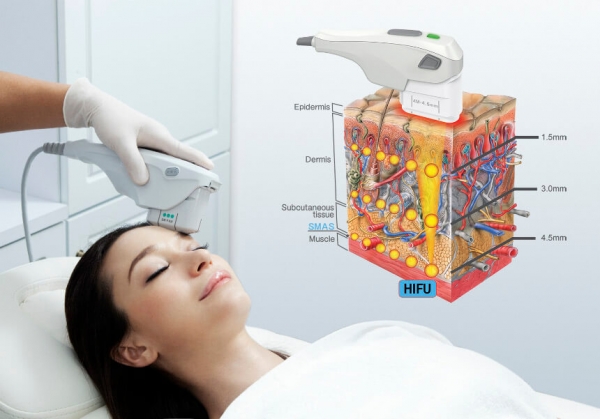
High-Intensity Focused Ultrasound (HIFU) is the technology which utilizes ultrasound waves to focus energy on a specific point to achieve various purposes including cosmetic, medical, and surgical needs. It is valued as a non-invasive technique to treat various symptoms.
Mechanism
The mechanism of HIFU is relatively simple. Ultrasound waves are basically a form of mechanical energy of a certain magnitude. Just as light collected by a magnifying glass can initiate fire, when multiple waves converge at one spot by a special HIFU transducer, the energy held by each wave is focused, increasing the temperature and energy level of that point. Our body is composed of various cells. Each cell is different in features and roles but most are inferior to excessive heat - therefore, when they are exposed to sufficient amount of heat, denaturation or cell necrosis occur. Use of HIFU can elevate the temperature of tissues up to 100 degrees Fahrenheit, causing immediate cell necrosis. However, when magnitude of energy is controlled, intense, but relatively low, temperature can be achieved. In this case, thermal fixation may occur. Thermal fixation refers to the phenomenon where cells are not led to immediate lysis but left with significant damage, making them defective. Such two results may be used in various treatments utilizing the different characteristics of cell lysis. Furthermore, mechanical influences such as acoustic cavitation, radiation force, and microstreaming can also be induced by HIFU. Despite its possibilities, HIFU has yet been developed for wide usage as the required visual aid compulsory during treatment was not entirely refined. However the recent advance in imaging technology- specifically in MR and Ultrasound- allowed clinicians to identify whether any obstacles lie in the path of energy and perform sophisticated surgeries, allowing HIFU technology application to flourish.
Applications
Such versatile aspect of HIFU allows it to be used in various situations:
-Medical Usage
HIFU is currently being used and gaining attention for its ability to treat brain tumor and cancer. As mentioned above, HIFU is capable of destroying certain cells in the human body, and recent application to cancer treatment showed significant progress in destroying the targeted tumors within the body. HIFU technology is very similar to the technology of ultrasound imaging or sonography, which uses ultrasound waves to image inner body structures such as organs or blood vessels. Due to the similarity of the two techniques, both can be used together within a single treatment. Sonography identifies the target tumor cells for the HIFU to aim and, without harming adjacent cells, promotes cell necrosis. Currently, the FDA (Food and Drug Administration) has approved HIFU treatment for certain symptoms including prostate cancer and symptomatic uterine fibroids. However research is ongoing for other diseases including but not limited to bone, brain, breast, liver, pancreas, and kidney cancers
-Cosmetic Usage
HIFU gained most popularity in cosmetic treatments. The two most appreciated treatments are anti-aging (Ultherapy) and fat removal (Liposonix). As HIFU can successfully lead cells to necrosis, it can also be used to ablate tissues as well. The technology is therefore applicable in non-invasive liposuction. Liposonix is the surgical process of removing fat. Using the same principles explained above, liposonix uses HIFU to heat and kill fat cells in targeted area. Our body, after indicating the death of the targeted fat cells, slowly removes those dead fat cells and eventually, up to an inch of fat layer is removed from patient’s body. Ultherapy refers to a wrinkle removal and skin lifting treatment where HIFU is used to create coagulation points within certain depths - 1.5, 3.0, and 4.5 mm - of the skin. As a coagulation point is created, collagen is denatured through heat and ultimately activates collagen synthesis. In this process, contraction occurs within nearby tissue, and this contraction ultimately tightens the skin and reduces wrinkles.
Future Aspect
Current applications of HIFU are limited to the ablation and heating of cells due to the focus on the thermal aspect of HIFU. Of course, with the development of imaging technology and better targeting means, the application capabilities of the thermal aspect of HIFU is immense. However, researchers currently are working on applications of the mechanical effects of HIFU, aftereffect of existing HIFU treatments, and low energy HIFU treatments. Papers have shown recent work on relatively novel subjects such as enhancement of drug delivery and cancer-specific immunity using HIFU technology. Despite relatively unknown, HIFU offers much possibility in the treatment of many diseases that require a sophisticated approach as a non-invasive technique.


